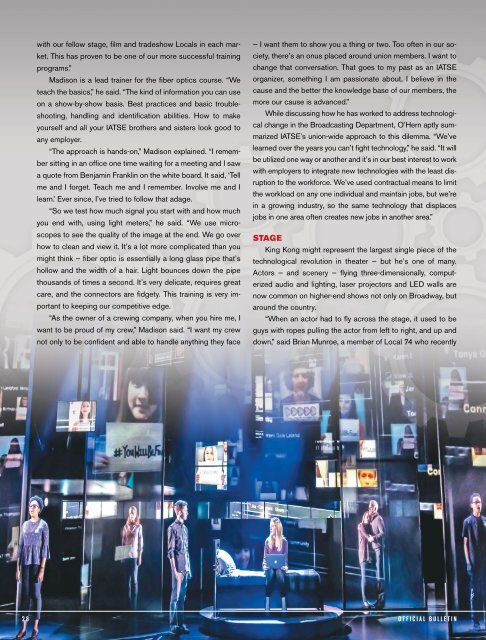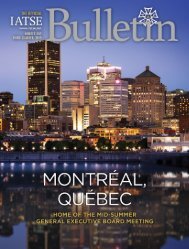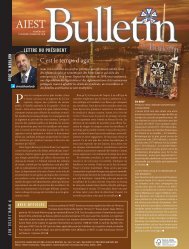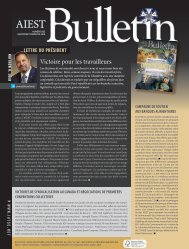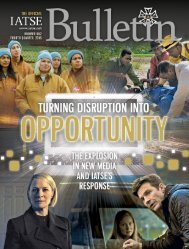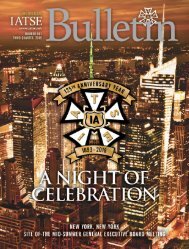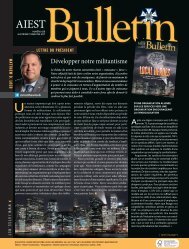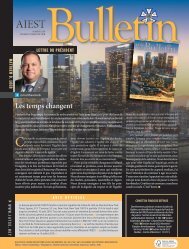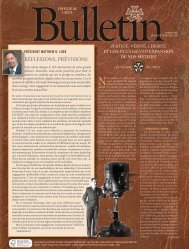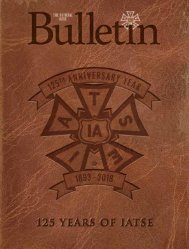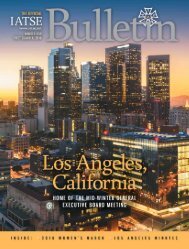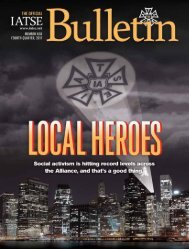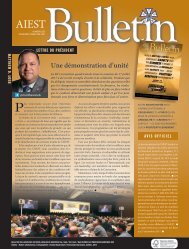The Official Bulletin - Quarter 2, 2019
- No tags were found...
Create successful ePaper yourself
Turn your PDF publications into a flip-book with our unique Google optimized e-Paper software.
with our fellow stage, film and tradeshow Locals in each market.<br />
This has proven to be one of our more successful training<br />
programs.”<br />
Madison is a lead trainer for the fiber optics course. “We<br />
teach the basics,” he said. “<strong>The</strong> kind of information you can use<br />
on a show-by-show basis. Best practices and basic troubleshooting,<br />
handling and identification abilities. How to make<br />
yourself and all your IATSE brothers and sisters look good to<br />
any employer.<br />
“<strong>The</strong> approach is hands-on,” Madison explained. “I remember<br />
sitting in an office one time waiting for a meeting and I saw<br />
a quote from Benjamin Franklin on the white board. It said, ‘Tell<br />
me and I forget. Teach me and I remember. Involve me and I<br />
learn.’ Ever since, I’ve tried to follow that adage.<br />
“So we test how much signal you start with and how much<br />
you end with, using light meters,” he said. “We use microscopes<br />
to see the quality of the image at the end. We go over<br />
how to clean and view it. It’s a lot more complicated than you<br />
might think — fiber optic is essentially a long glass pipe that’s<br />
hollow and the width of a hair. Light bounces down the pipe<br />
thousands of times a second. It’s very delicate, requires great<br />
care, and the connectors are fidgety. This training is very important<br />
to keeping our competitive edge.<br />
“As the owner of a crewing company, when you hire me, I<br />
want to be proud of my crew,” Madison said. “I want my crew<br />
not only to be confident and able to handle anything they face<br />
— I want them to show you a thing or two. Too often in our society,<br />
there’s an onus placed around union members. I want to<br />
change that conversation. That goes to my past as an IATSE<br />
organizer, something I am passionate about. I believe in the<br />
cause and the better the knowledge base of our members, the<br />
more our cause is advanced.”<br />
While discussing how he has worked to address technological<br />
change in the Broadcasting Department, O’Hern aptly summarized<br />
IATSE’s union-wide approach to this dilemma. “We’ve<br />
learned over the years you can’t fight technology,” he said. “It will<br />
be utilized one way or another and it’s in our best interest to work<br />
with employers to integrate new technologies with the least disruption<br />
to the workforce. We’ve used contractual means to limit<br />
the workload on any one individual and maintain jobs, but we’re<br />
in a growing industry, so the same technology that displaces<br />
jobs in one area often creates new jobs in another area.”<br />
STAGE<br />
King Kong might represent the largest single piece of the<br />
technological revolution in theater — but he’s one of many.<br />
Actors — and scenery — flying three-dimensionally, computerized<br />
audio and lighting, laser projectors and LED walls are<br />
now common on higher-end shows not only on Broadway, but<br />
around the country.<br />
“When an actor had to fly across the stage, it used to be<br />
guys with ropes pulling the actor from left to right, and up and<br />
down,” said Brian Munroe, a member of Local 74 who recently<br />
28 OFFICIAL BULLETIN


